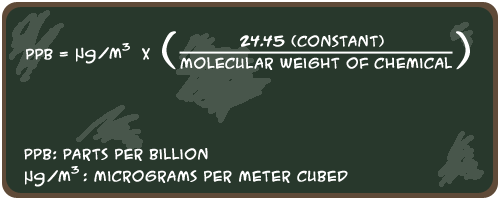For air toxics, concentration refers to the total amount of a chemical contained in a specific amount of air, by volume or mass. Today’s technology enables chemicals to be measured in extremely small amounts, expressed in proportions and/or mass.
Scientists frequently use proportions to express the amount of chemicals in the air. It is common for measurements to be very small. For example, the proportion of a chemical in the total weight or volume of an air sample are often as small as parts per million (ppm) and parts per billion (ppb). In air, a number of 5 ppb would mean that there are 5 parts of the chemical for every billion parts of everything else in the air. To help visualize these small amounts, think of one ppm as one minute in two years. One ppb is 1,000 times smaller.
Scientists also use milligrams per cubic meter (mg/m3) or micrograms per cubic meter (µg/ m3) to express the mass of the chemical (milligrams, micrograms) per volume of air (cubic meter). Like ppm and ppb, these are very small measurements. A chemical concentration of 10 µg/m3 means that there are 10 micrograms of a chemical in every cubic meter of air. In some cases, scientists change an expression from mass to ppm and/or ppb. This is done by applying a conversion factor, because 5 ppb does not mean the same thing as 5 µg/m3.

The Air Toxics Program within IDEM’s Office of Air Quality uses data on chemical concentrations for air risk assessments.
